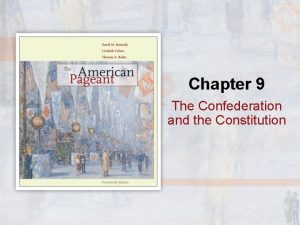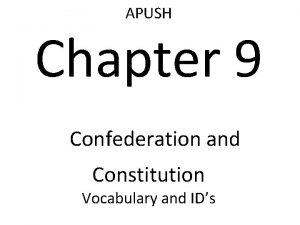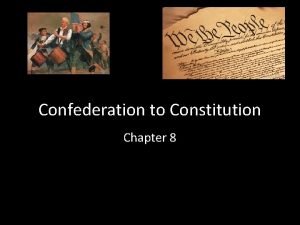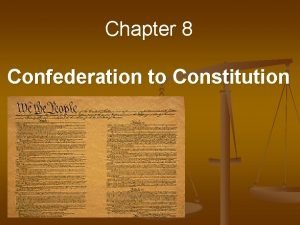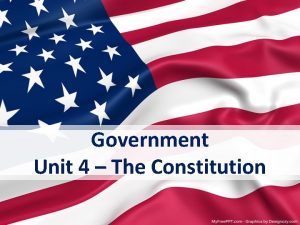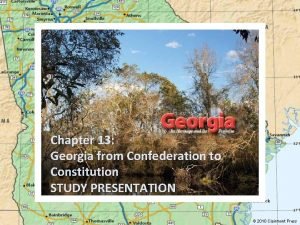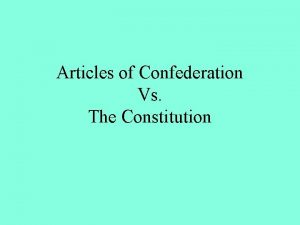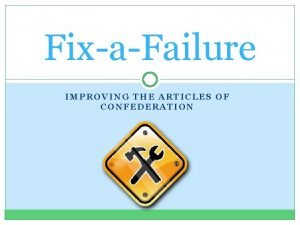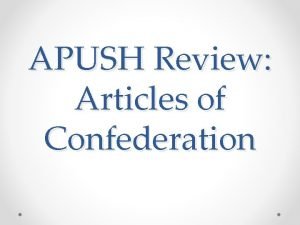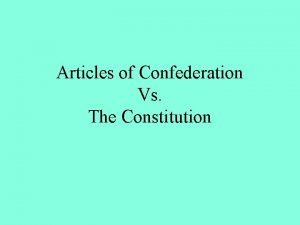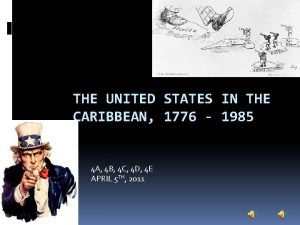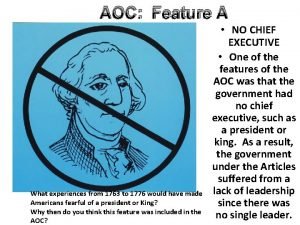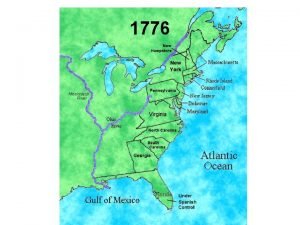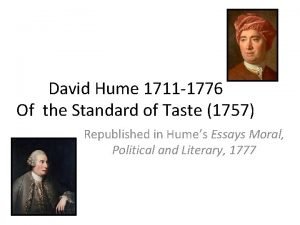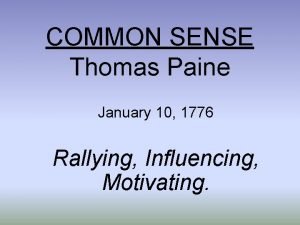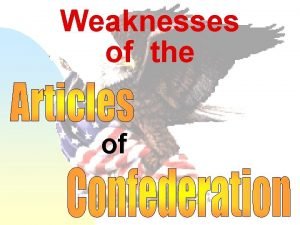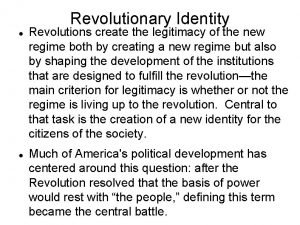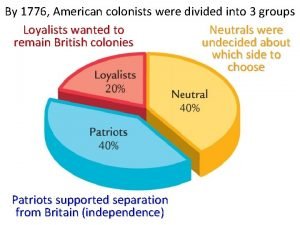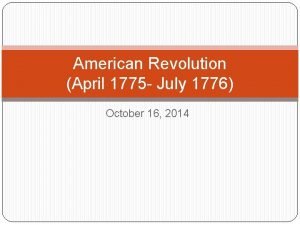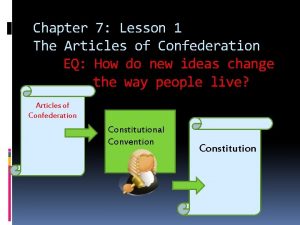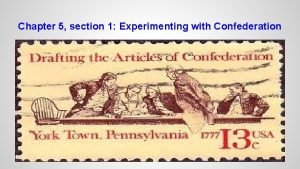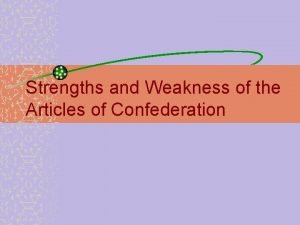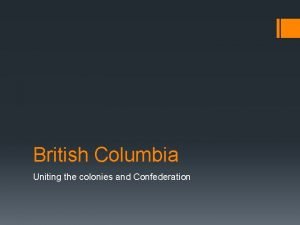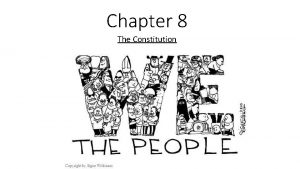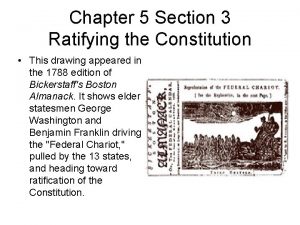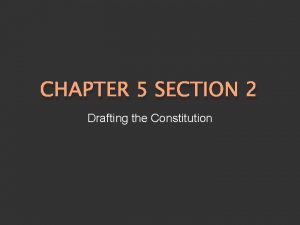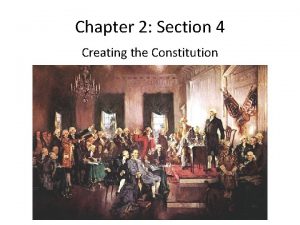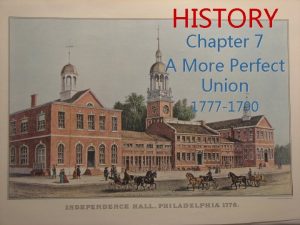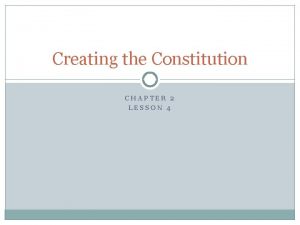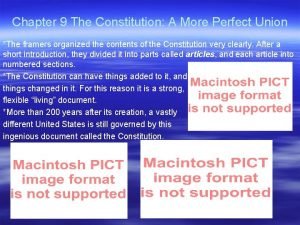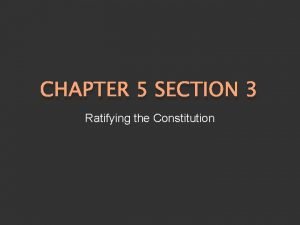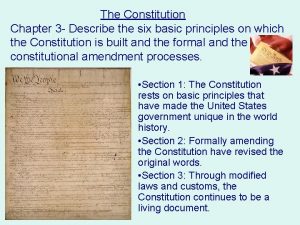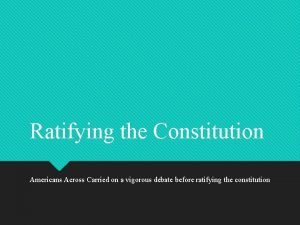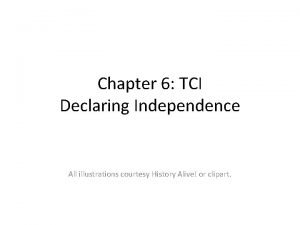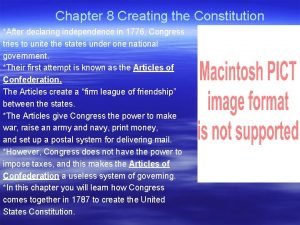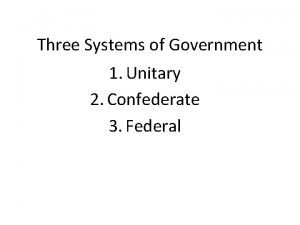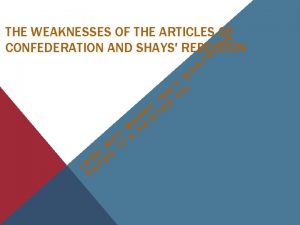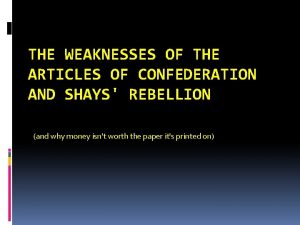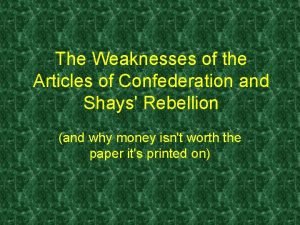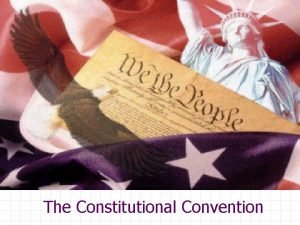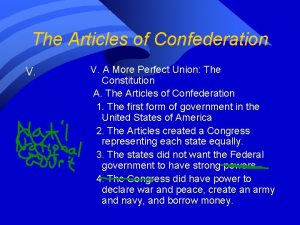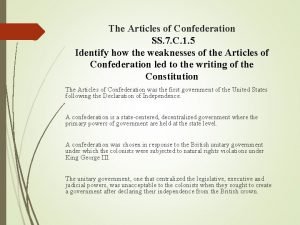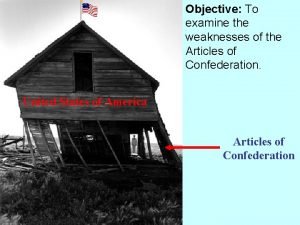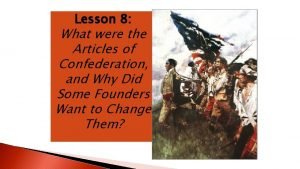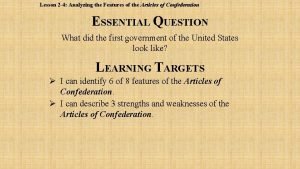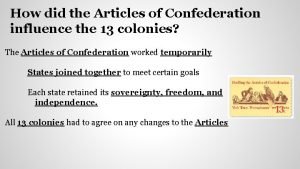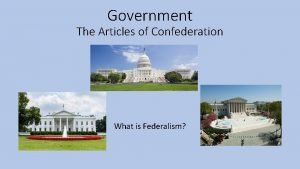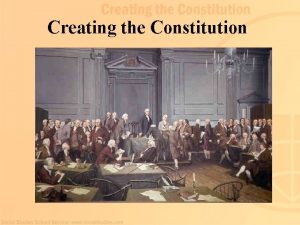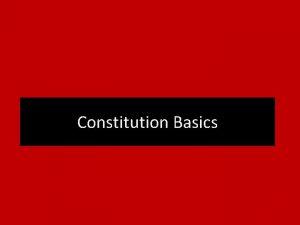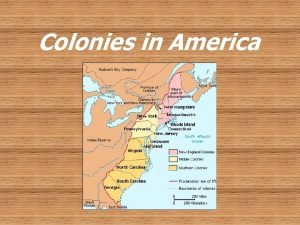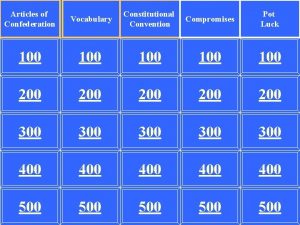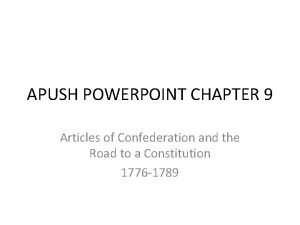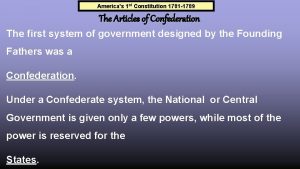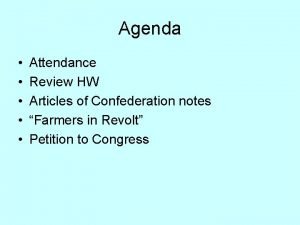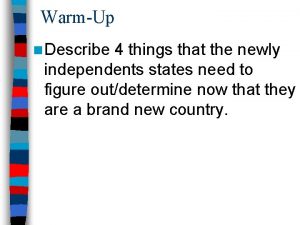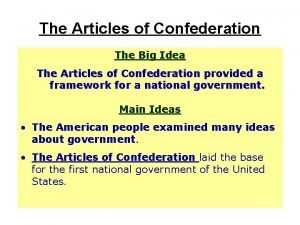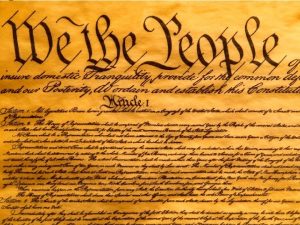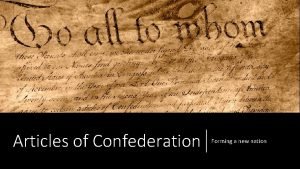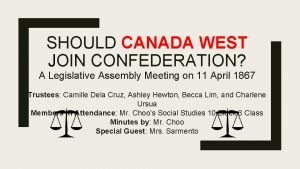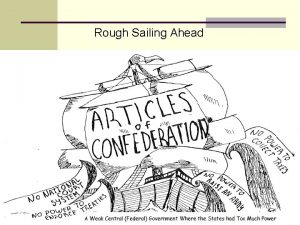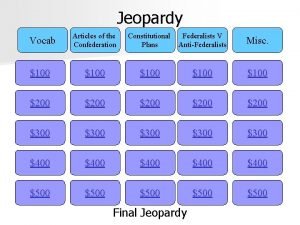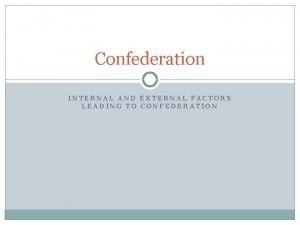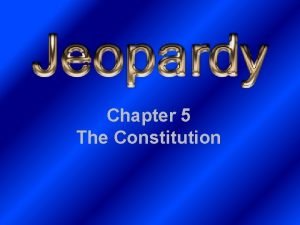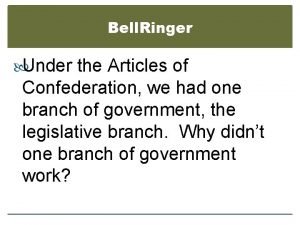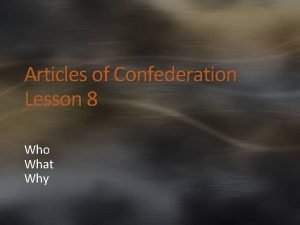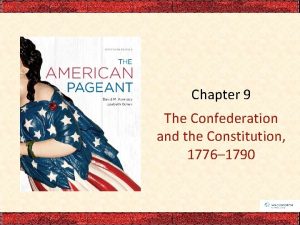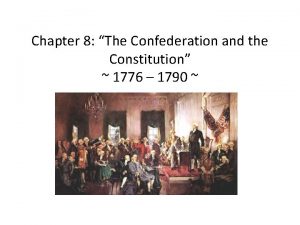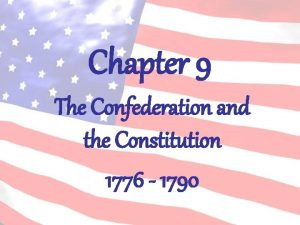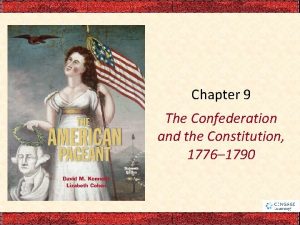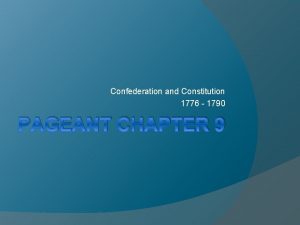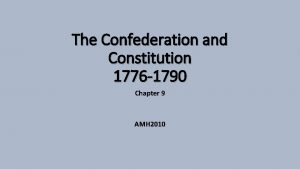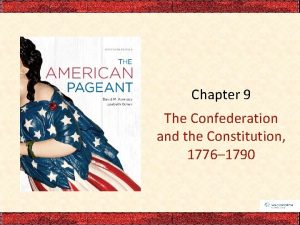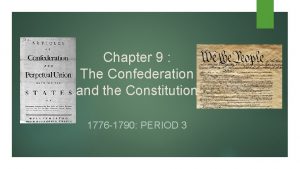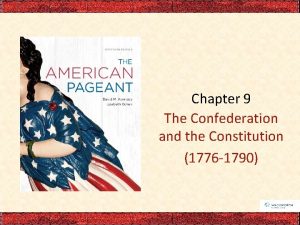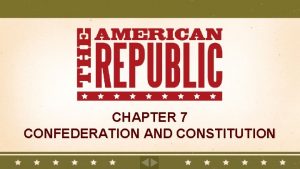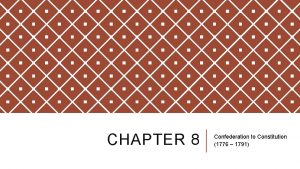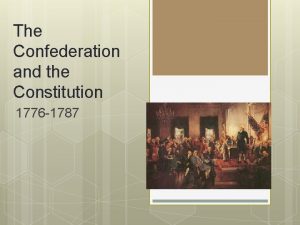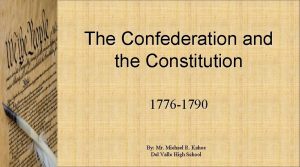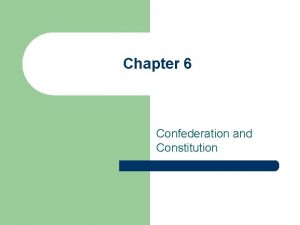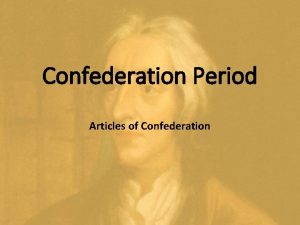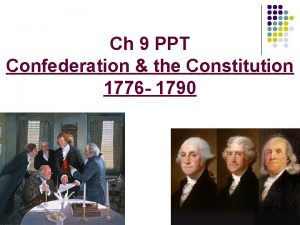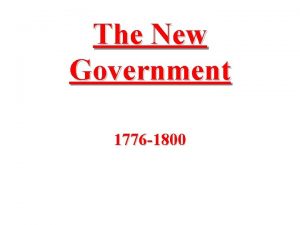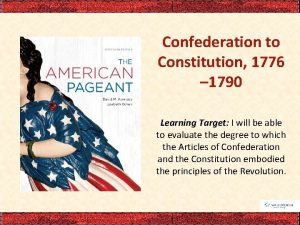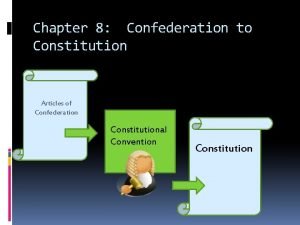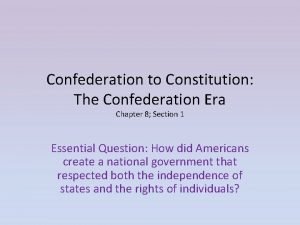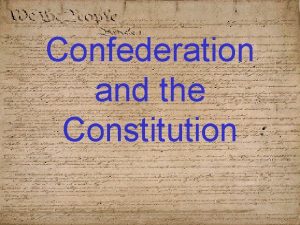Chapter 9 The Confederation and the Constitution 1776
















































































- Slides: 80

Chapter 9 The Confederation and the Constitution, 1776– 1790

p 158

p 159

I. A Shaky Start Toward Union • Disruptive forces stalked the land: – Departed Tories left political system inclined toward experimentation and innovation – Economy stumbled post-Revolution • Yet thirteen sovereign states: – Shared similar political structures – Enjoyed rich political inheritance – Were blessed with good political leaders

II. Constitution Making in the States • Constitutional Congress in 1776 called on colonies to draft new state constitutions: – Asked colonies to summon themselves into being as new states – Sovereignty of new states would rest on authority of the people – Connecticut and Rhode Island merely retouched their colonial charters – Others would write new constitutions

II. Constitution Making in the States (cont. ) • Massachusetts called for special convention to draft its constitution and then submitted final draft to the people for ratification: – Once adopted, constitution could only be changed by another constitutional convention – Its constitution remained longest-lived constitution in world

II. Constitution Making in the States (cont. ) • Common constitutional features: – As written documents, constitutions represented fundamental law, superior to ordinary legislation – Most contained bills of rights— protect prized liberties against legislative encroachment – Most required annual election of legislators – All created weak executive and judicial branches

II. Constitution Making in the States (cont. ) • In new governments, legislatures were granted sweeping powers: – Democratic character reflected by presence of many from recently enfranchised western districts – Their influence was demonstrated when some states moved capitals into interior

III. Economic Crosscurrents • Economic changes: – States seized control of former crown lands – Land was cheap and easily available – In America, economic democracy preceded political democracy – Revolution also stimulated manufacturing

III. Economic Crosscurrents (cont. ) • Drawbacks of economic independence: – Most British commerce reserved for loyal parts of the empire – American ships now barred from British and British West Indies harbors – Fisheries were disrupted • Americans could freely trade with foreign nations – New commercial outlets (e. g. , China in 1784) partially compensated for loss of old ones

p 162

p 163

III. Economic Crosscurrents (cont. ) • War spawned demoralizing speculation and profiteering. • State governments borrowed more than they could repay. • Runaway inflation ruined many. • Average citizen was worse off financially at the end of Revolution than at start.

III. Economic Crosscurrents (cont. ) • Whole economic and social atmosphere was unhealthy: – A newly rich class of profiteers was conspicuous – Once-wealthy people were destitute • Controversies leading to Revolution had bred: – keen distaste for taxes – encouraged disrespect for laws in general

IV. Creating a Confederation • Second Continental Congress: – Little more than a conference of ambassadors – Was totally without constitutional authority – Asserted some control over military and foreign policy • In all respects, thirteen states were sovereign: – Coined money – Raised armies and navies – Erected tariff barriers

IV. Creating a Confederation (cont. ) • Articles of Confederation: – Adopted by Congress in 1777, but not ratified by states until 1781 • Chief point of contention was western lands: – 6 states had no holdings beyond Allegheny Mtns – 7 (esp. New York & Virginia) held huge acreage – Land-rich states could use trans-Allegheny tracts to pay off debts

IV. Creating a Confederation (cont. ) – Unanimous approval of Articles by all thirteen states was required: • Maryland held out until March 1781 to get agreement by New York to surrender its western lands • Congress pledged to dispose of these vast areas for “common benefit” • Promised to carve out a number of “republican” states, which overtime would be admitted to union • Pledge redeemed in Northwest Ordinance of 1787 (see Map 9. 1). • Disposal of western lands helped encourage union

Map 9 -1 p 164

V. The Articles of Confederation: America's First Constitution • Articles of Confederation: – Provided for loose confederation or “firm league of friendship” – thirteen independent states linked together to deal with common problems, such as foreign affairs – Congress was chief agency – No executive branch – Judicial issues left almost exclusively to states

V. The Articles of Confederation: America's First Constitution (cont. ) • Congress, though dominant, was hobbled: – Each state had a single vote – All important bills required support of nine states – Any amendment to Articles required unanimous ratification – Congress was weak—and was purposely designed to be weak

V. The Articles of Confederation: America's First Constitution (cont. ) • Two major weakness of Articles: – Congress had no power to regulate commerce – Congress could not enforce its own tax-collection • Congress could advise, advocate, and appeal: – In dealing with states, it could not coerce or control – Nor could it act directly on individuals

V. The Articles of Confederation: America's First Constitution (cont. ) • New Congress, with paper power, was less effective than Continental Congress. • Yet, Articles proved to be a landmark: – As first written constitution of Republic, Articles were significant step toward later Constitution – Outlined general powers of national government – Kept alive ideal of union and held states together – Witho Articles, great leap from old Association of 1774 to current Constitution not possible

p 165

VI. Landmarks in Land Laws • Passages of public domain legislation: – Old Northwest = area northwest of Ohio River, east of Mississippi River, south of Great Lakes – Land Ordinance of 1785 (see Map 9. 2) set up orderly process to sell land in Old Northwest and use proceeds to pay national debt: • After surveyed, land divided into townships, then into sections • Sixteenth section sold to fund education

Map 9 -2 p 166

VI. Landmarks in Land Laws (cont. ) • Northwest Ordinance of 1787: – Governance of old Northwest -- how nation would deal with its colonies: • First temporary tutelage, then permanent equality • First, two evolutionary territorial stages under subordination to federal government • Once a territory had 60, 000 inhabitants, it could be admitted by Congress as a state • Ordinance forbad slavery in old Northwest

VII. The World's Ugly Duckling • Relations with Britain remained troubled: – England refused to send a minister to America – Declined to negotiate a commercial treaty or to repeal Navigation Laws – Closed West Indies trade to the states – Tried, with help of Allen brothers of Vermont, to annex rebellious area to Canada – Maintained a chain of trading posts on U. S. soil – Continued fur trade with Indians

VII. The World's Ugly Duckling: (cont. ) • Spain was openly hostile to new Republic: • Controlled all-important Mississippi River on which pioneers shipped their produce • In 1784 Spain closed river to American commerce threatening West with strangulation • Claimed large areas north of Gulf of Mexico • Schemed with Indians to keep Americans east of Appalachians • Because Spain & Britain influenced Indians, America unable to exercise control over half of its territory (see Map 9. 3).

Map 9 -3 p 167

VII. The World's Ugly Duckling (cont. ) • France, America's friend, cooled off now that Britain humbled • North African pirates ravaged America's Mediterranean commence • New nation too weak to fight pirates and too poor to pay bribes.

VII. The Horrid Specter of Anarchy • Economic problems, mid-1780 s: – System of raising tax money was breaking down – Interest on public debt was escalating – Some states were levying their own duties – Some were printing depreciated paper money • Shays's Rebellion in western Massachusetts: – Impoverished farmers lost land through mortgage foreclosures and tax delinquencies

VII. The Horrid Specter of Anarchy (cont. ) • Led by Captain Daniel Shays, desperate debtors demanded: – State issue paper money, lighten taxes, and suspend property takeovers – Hundreds attempted to enforce demands – Massachusetts authorities responded by raising small army and skirmishes occurred – After 3 Shaysites killed and one wounded, movement collapsed

VII. The Horrid Specter of Anarchy (cont. ) • Shays's followers were crushed, but memory remained: – Massachusetts passed debtor-relief laws – Shays's outburst caused fear among propertied class – Civic virtue insufficient to rein in self-interest – Needed stronger central government to block “mobocracy”

p 168

VII. The Horrid Specter of Anarchy (cont. ) • How critical were conditions under Articles? – Conservatives, protecting their wealth, exaggerated seriousness of nation's plight – They sought to amend Articles to create more muscular central government – Both friends and critics of the Confederation agreed it needed strengthening, but disagreed over how much its powers should be increased – Economy actually improved, late 1780 s

IX. A Convention of “Demigods” • Annapolis convention of 1786: – Called to deal with commercial disputes – Nine states appointed delegates, only 5 attended – Alexander Hamilton got convention to call for meeting in Philadelphia in 1787 to bolster entire fabric of Articles of Confederation – Eventually Congress agreed to a convention “for the sole and express purpose of revising” Articles – Each state sent representatives, except Rhode Island

IX. A Convention of “Demigods” (cont. ) • 55 emissaries from 12 states convened in Philadelphia on May 25, 1787 • Sessions were held in secrecy, with armed sentinels at doors • Caliber of participants was extraordinarily high— “demigods, ” Jefferson called them • Most were lawyers with experience at state constitution-making • George Washington was elected chairman • Benjamin Franklin served as elder statesman

IX. A Convention of “Demigods” (cont. ) • James Madison's contributions were so notable he was dubbed “the Father of the Constitution” • Alexander Hamilton advocated a super-powerful central government • Most Revolutionary leaders of 1776 were absent • Jefferson, J. Adams, and Thomas Paine in Europe • Samuel Adams & John Hancock were not elected • Patrick Henry was elected from Virginia, but declined, declaring he “smelled a rat. ” – Time had come to fashion a solid political system

p 170

X. Patriots in Philadelphia • The 55 delegates: • A conservative, well-to-do body of lawyers, merchants, shippers, land speculators, moneylenders • Not a single person from the debtor groups • Young (average 42) but experienced statesmen • Nationalists, more interested in preserving young Republic then stirring popular democracy • Hoped to crystallize evaporating pools of Revolutionary idealism into stable political structure that would endure

X. Patriots in Philadelphia (cont. ) Wanted a firm, dignified, & respected government: • Believed in republicanism, but sought to protect American experiment from weakness abroad and excesses at home • Wanted central government to control tariffs in order to secure commercial treaties from foreign nations • Determined to preserve union, forestall anarchy, and ensure security of life & property against uprisings by “mobocracy” • Curb unrestrained democracy rampant in several states • Motivated by fear

XI. Hammering Out a Bundle of Compromises • Some delegates decided to completely scrap Articles of Confederation – Despite explicit instructions from Congress to revise – Were determined to overthrow existing government by peaceful means (see Table 9. 1)

Table 9 -1 p 171

XI. Hammering Out a Bundle of Compromises (cont. ) • Proposals: • Virginia Plan—“large-state plan”: representation in both houses of bicameral Congress would be based on population—an arrangement that advantaged larger states • New Jersey Plan—“small-state plan”: provided for equal representation in unicameral Congress, regardless of size and population – Bitter debate Because small states feared Virginia scheme would allow domination by large states

XI. Hammering Out a Bundle of Compromises (cont. ) • The Great Compromise: • Larger states gained representation by population in House of Representatives (Art. I, Sec. II, para. 3 see the Appendix) • Smaller states were appeased by equal representation in Senate (Art. I, Sec. III, para. 1) • Agreed that all tax bills or revenue measures must originate in House, where population counted more heavily (Art. I, Sec. VII, para. 1). • Compromise broke deadlock

XI. Hammering Out a Bundle of Compromises (cont. ) • The final Constitution was: • Short Because grew from Anglo-American common law legal tradition • Provide flexible guide to broad rules of procedures rather than detailed laws • The original (unamended) Constitution contained just 7 articles and took about 10 pages to print

XI. Hammering Out a Bundle of Compromises (cont. ) • The President: • Broad authority to make appointments to domestic offices, including judgeships • Power to veto legislation • Not absolute power to wage war • Congress retained crucial right to declare war • Constitution a bundle of compromises: – Elect president indirectly by Electoral College rather than by direct means

p 172

XI. Hammering Out a Bundle Compromises (cont. ) – A state's share of electors based on total of its senators and representatives in Congress (see Art. II, Sec. I, para. 2) – Slavery and Constitution (see Table 9. 2): • Three-fifths compromise: slave as three-fifths of a person for representation (see Art. I, Sec. II, para. 3) • Slave trade could continue until end of 1807 (see Art. I, Sec. IX, para 1).

Table 9 -2 p 173

XII. Safeguards for Conservatism • Agreement among delegates was large: – Economically, they demanded sound money and protection of private property – Politically, they favored a strong government with three branches, and with checks & balances – Rejected manhood-suffrage democracy

XII. Safeguards for Conservatism (cont. ) – Erected safeguards against excesses of “mob”: • Federal judges were appointed for life • President to be elected indirectly by Electoral College • Senators were chosen indirectly by state legislatures (see Art. I, Sec. III, para. 1) • In House of Representatives, qualified (propertied) citizens permitted to choose their officials by direct vote (see Art. 1, Sec. II, para. 1).

XII. Safeguards for Conservatism (cont. ) • Democratic elements in new charter: – Stood on two great principles of republicanism • Only legitimate government was one based on consent of the governed • Powers of government should be limited—in this case by a written constitution • Virtue of the people, not authority of the state, was ultimate guarantor of liberty, justice, and order • After 17 weeks—May 25 to September 17, 1787— only 42 of original 55 remained to sign Constitution • 3 of 42 refused to sign

XIII. The Clash of Federalists and Antifederalists • Framers foresaw that nationwide acceptance of Constitution would be difficult: – Unanimous ratification by all thirteen states required by still-standing Articles of Confederation – Because Rhode Island certain to veto, delegates stipulated that when 9 states had approved through specifically elected conventions, Constitution would be supreme law in those states (see Art. VII).

XIII. The Clash of Federalists and Antifederalists (cont. ) • American people were handed a new document (see Table 9. 3): – Antifederalists—opposed a stronger federal government – Federalists—supported a strong federal government

XIII. The Clash of Federalists and Antifederalists (cont. ) – Antifederalists (Samuel Adams, Patrick Henry, Richard Henry Lee) were states' rights devotees (see Map 9. 4), backcountry dwellers, small farmers, paper-moneyites and debtors – Federalists (George Washington, Benjamin Franklin) were those who lived on seaboard, wealthy, educated, better organized – Antifederalists argued document drafted by elite would weaken states & threaten individual liberties

Table 9 -3 p 174

XIV. The Great Debate in the States • Special elections held for members of ratifying conventions (see Table 9. 4) – Candidates—federalist or antifederalist—were elected based on whether they were for or were against Constitution • Four small states quickly accepted Constitution • Pennsylvania was first large state to ratify • Massachusetts presented challenges, including demand for bill of rights

Map 9 -4 p 175

Table 9 -4 p 175

XIV. The Great Debate in the States (cont. ) – Once assured of such a protection, Massachusetts ratified by margin of 187 to 168 – Three more states then signed – New Hampshire was the last – All but Virginia, New York, North Carolina, and Rhode Island had taken shelter under “new federal roof” – Document officially signed on June 21, 1788

XV. The Four Laggard States • Virginia: • Provided fierce antifederalist opposition • They claimed document was death warrant of liberty • Federalists G. Washington, J. Madison, and John Marshall lent influential support • After intensive debate, state convention ratified it 89 to 79

p 176

XV. The Four Laggard States (cont. ) • New York: • Alexander Hamilton joined John Jay and James Madison in a series of federalist newspaper articles • The Federalist Papers were most penetrating commentary ever written on Constitution • Most famous one is Madison's Federalist No. 10 • Refuted that it was impossible to extend a republican form of government over a large territory • New York finally yielded, ratifying by count of 30 to 27

XV. The Four Laggard States (cont. ) – North Carolina, after a hostile convention, adjourned without taking a vote – Rhode Island didn't summon a convention, rejected Constitution by popular referendum – Two most ruggedly individualist centers remained true to form

p 177

XV. The Four Laggard States (cont. ) • No lives were lost, but riots broke out in New York and Pennsylvania. • Lots of behind-the-scenes pressure on delegates who had promised to vote against Constitution. • Last four states ratified, not because they wanted to, but because they had to: – Could not safely exist outside new nation

XVI. A Conservative Triumph • A minority triumphed—twice: – A militant minority of radicals engineered military Revolution that cast off British constitution – A militant minority of conservatives engineered peaceful revolution that overthrew inadequate Articles of Confederation – A majority had not spoken: • Only ¼ of adult white males voted for delegates to ratifying conventions

XVI. A Conservative Triumph (cont. ) • Conservatism was victorious, but principles of republican government were maintained through a redefinition of popular sovereignty: – Antifederalists claimed only legislatures could represent the people – Federalists claimed each branch of new government could represent the people – With self-limiting system of checks and balances among 3 branches, Constitution reconciled conflicting principles of liberty and order

XVII. The Pursuit of Equality • Equality was watchword everywhere: – Most states reduced property-holding requirements for voting – Ordinary men and women demanded to be addressed as “Mr. ” and “Mrs. ” – Employers called “boss, ” not “master” – Pretentious Continental Army officials who formed Society of the Cincinnati faced ridicule

XVII. Pursuit of Equality (cont. ) • Protracted fight to separate church and state resulted in notable gains: – Anglican Church disestablished; reformed as Protestant Episcopal Church – Struggle to separate religion and government proved fierce in Virginia – In 1786 Thomas Jefferson and co-reformers won with passage of Virginia Statute for Religious Freedom (see Table 5. 1).

XVII. Pursuit of Equality (cont. ) • Egalitarian sentiments challenged slavery: – Philadelphia Quakers in 1775 founded world's first antislavery society – Several Northern states called for either abolishing slavery outright or for gradual emancipation – Even in Virginia, a few idealistic masters freed their slaves

XVII. Pursuit of Equality (cont. ) Revolution of sentiments was incomplete – Domestic slave trade grew dramatically – Most of North end slavery only gradually – No state south of Pennsylvania abolished slavery – In both North and South, law discriminated against freed blacks and slaves alike

XVII. Pursuit of Equality (cont. ) • Why not more rapid changes: – Fledgling idealism of Founding Fathers was sacrificed to political expediency – A fight over slavery would fracture fragile union • “Great as the evil (of slavery) is, a dismemberment of the union would be worse” James Madison (1787) – Nearly a century later, slavery did wreck Union— temporarily

XVII. The Pursuit of Equality (cont. ) • Also incomplete was extension of equality to women: – New Jersey's new constitution (1776) for a while allowed women to vote – In general civil status of women not changed

XVII. The Pursuit of Equality (cont. ) • Central to republican ideology was: – Civic virtue—democracy depended on unselfish commitment of each citizen to public good – Who could better cultivate virtue than mothers to whom society entrusted moral education of young – Idea of “republican motherhood” elevated women to prestigious role as special keepers of nation's conscience

p 178

XVII. The Pursuit of Equality (cont. ) – Educational opportunities for women expanded so wives and mothers could better cultivate virtues demanded by Republic – Republican women now bore responsibility for survival of nation

p 179

p 181
 Chapter 9 the confederation and the constitution
Chapter 9 the confederation and the constitution Chapter 9 confederation and constitution
Chapter 9 confederation and constitution Chapter 8 confederation to constitution
Chapter 8 confederation to constitution Chapter 8 confederation to constitution
Chapter 8 confederation to constitution Articles of confederation vs constitution
Articles of confederation vs constitution Articles of confederation vs constitution
Articles of confederation vs constitution Constitution vs articles of confederation
Constitution vs articles of confederation Articles of confederation fail
Articles of confederation fail Articles of confederation vs constitution apush
Articles of confederation vs constitution apush Articles of confederation vs constitution chart
Articles of confederation vs constitution chart Texas constitution vs u.s. constitution venn diagram
Texas constitution vs u.s. constitution venn diagram Nc constitution vs us constitution
Nc constitution vs us constitution Constitution what is constitution
Constitution what is constitution The constitution lesson 1 principles of the constitution
The constitution lesson 1 principles of the constitution The united states in the caribbean 1776 to 1985
The united states in the caribbean 1776 to 1985 Middle colonies timeline
Middle colonies timeline Ccc1776
Ccc1776 What experiences from 1763 to 1776
What experiences from 1763 to 1776 1776-1607
1776-1607 May 1775
May 1775 Malcolm budd
Malcolm budd January 10th 1776
January 10th 1776 01 ssc 1776
01 ssc 1776 July 12 1776
July 12 1776 1787-1776
1787-1776 1776 divided by 3
1776 divided by 3 July 16 1776
July 16 1776 Chapter 7 lesson 1 answer key
Chapter 7 lesson 1 answer key Chapter 5 section 1 experimenting with confederation
Chapter 5 section 1 experimenting with confederation Characteristics of the articles of confederation
Characteristics of the articles of confederation Strengths and weaknesses of the articles of confederation
Strengths and weaknesses of the articles of confederation British columbia confederation pros and cons
British columbia confederation pros and cons Chapter 8 lesson 1 principles of the constitution
Chapter 8 lesson 1 principles of the constitution Chapter 5 section 3 ratifying the constitution
Chapter 5 section 3 ratifying the constitution Chapter 5 section 2 drafting the constitution
Chapter 5 section 2 drafting the constitution Section 4 creating the constitution
Section 4 creating the constitution Chapter 7 lesson 2 forging a new constitution
Chapter 7 lesson 2 forging a new constitution Chapter 2 lesson 4 creating the constitution answer key
Chapter 2 lesson 4 creating the constitution answer key Chapter 9 the constitution a more perfect union
Chapter 9 the constitution a more perfect union Ratifying the constitution chapter 5 section 3
Ratifying the constitution chapter 5 section 3 Chapter 3 section 1 constitution scavenger hunt answers
Chapter 3 section 1 constitution scavenger hunt answers Chapter 5 section 3 ratifying the constitution answer key
Chapter 5 section 3 ratifying the constitution answer key Tci declaration of independence
Tci declaration of independence Chapter 8 creating the constitution
Chapter 8 creating the constitution Confederation system of government
Confederation system of government Political weaknesses of the articles of confederation
Political weaknesses of the articles of confederation Confederacy examples
Confederacy examples What is a unitary system of government
What is a unitary system of government Achievements of the articles of confederation
Achievements of the articles of confederation Problems of articles of confederation
Problems of articles of confederation Articles of confederation strengths
Articles of confederation strengths Weaknesses of articles of confederation
Weaknesses of articles of confederation Articles of confederation strengths
Articles of confederation strengths Weaknesses of articles of confederation
Weaknesses of articles of confederation Failures of the articles of confederation
Failures of the articles of confederation New england confederation
New england confederation Achievements of the articles of confederation
Achievements of the articles of confederation Strengths of the articles of confederation
Strengths of the articles of confederation How did the articles of confederation fail
How did the articles of confederation fail Articles of confederation
Articles of confederation Federalism in the constitution
Federalism in the constitution Weaknesses of articles of confederation
Weaknesses of articles of confederation New england confederation
New england confederation Articles of confederation vocabulary
Articles of confederation vocabulary Articles of confederation apush
Articles of confederation apush Conventions to ratify constitutions apush
Conventions to ratify constitutions apush Achievements of the articles of confederation
Achievements of the articles of confederation Articles of confederation fail
Articles of confederation fail Acrostic poem articles of confederation
Acrostic poem articles of confederation A just right government
A just right government Articles of confederation big ideas
Articles of confederation big ideas What is the main idea of the articles of confederation
What is the main idea of the articles of confederation Apapdcl
Apapdcl Articles of confederation
Articles of confederation Why did canada west join confederation
Why did canada west join confederation Articles of confederation rough sailing ahead
Articles of confederation rough sailing ahead Articles of confederation jeopardy
Articles of confederation jeopardy Factors leading to confederation
Factors leading to confederation Constitution vocabulary part 2
Constitution vocabulary part 2 Articles of confederation bell ringer
Articles of confederation bell ringer Lesson 8 the articles of confederation
Lesson 8 the articles of confederation
